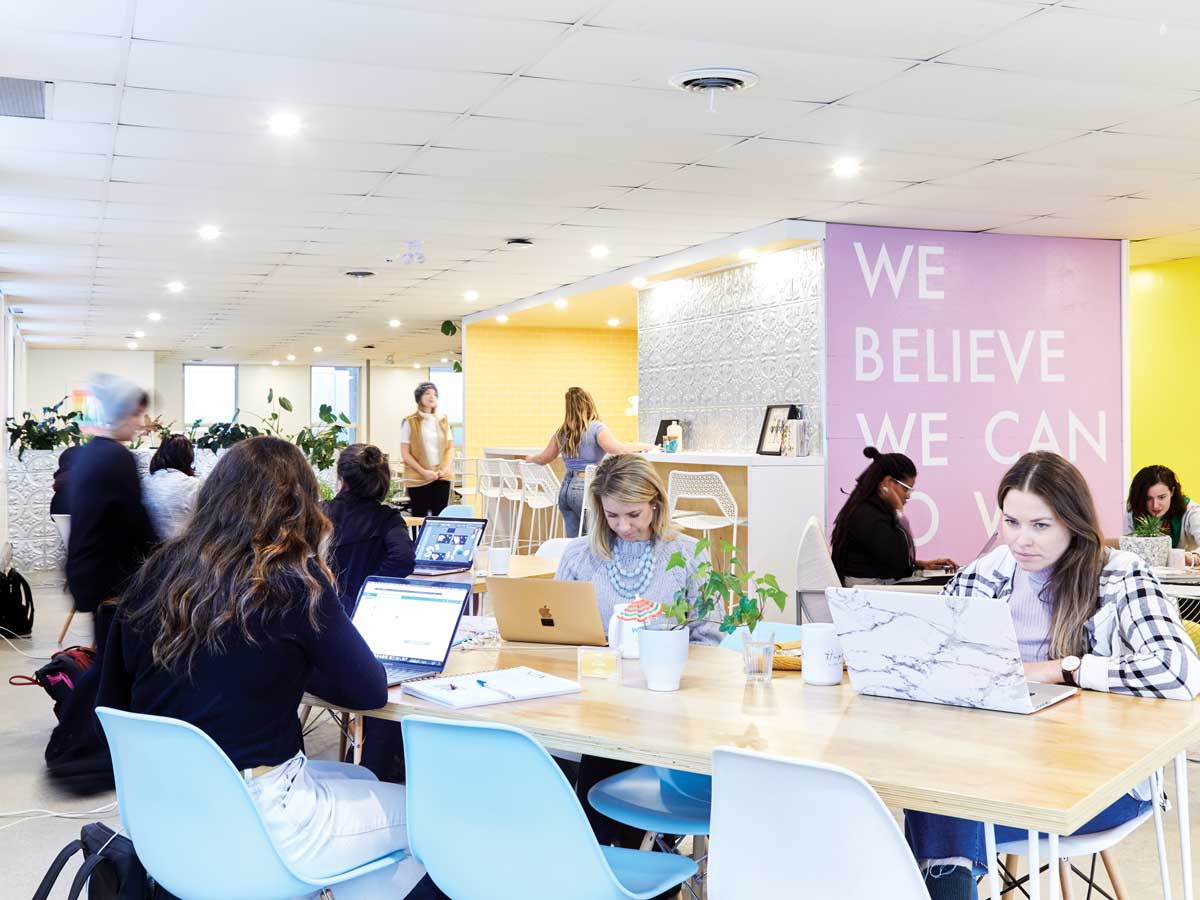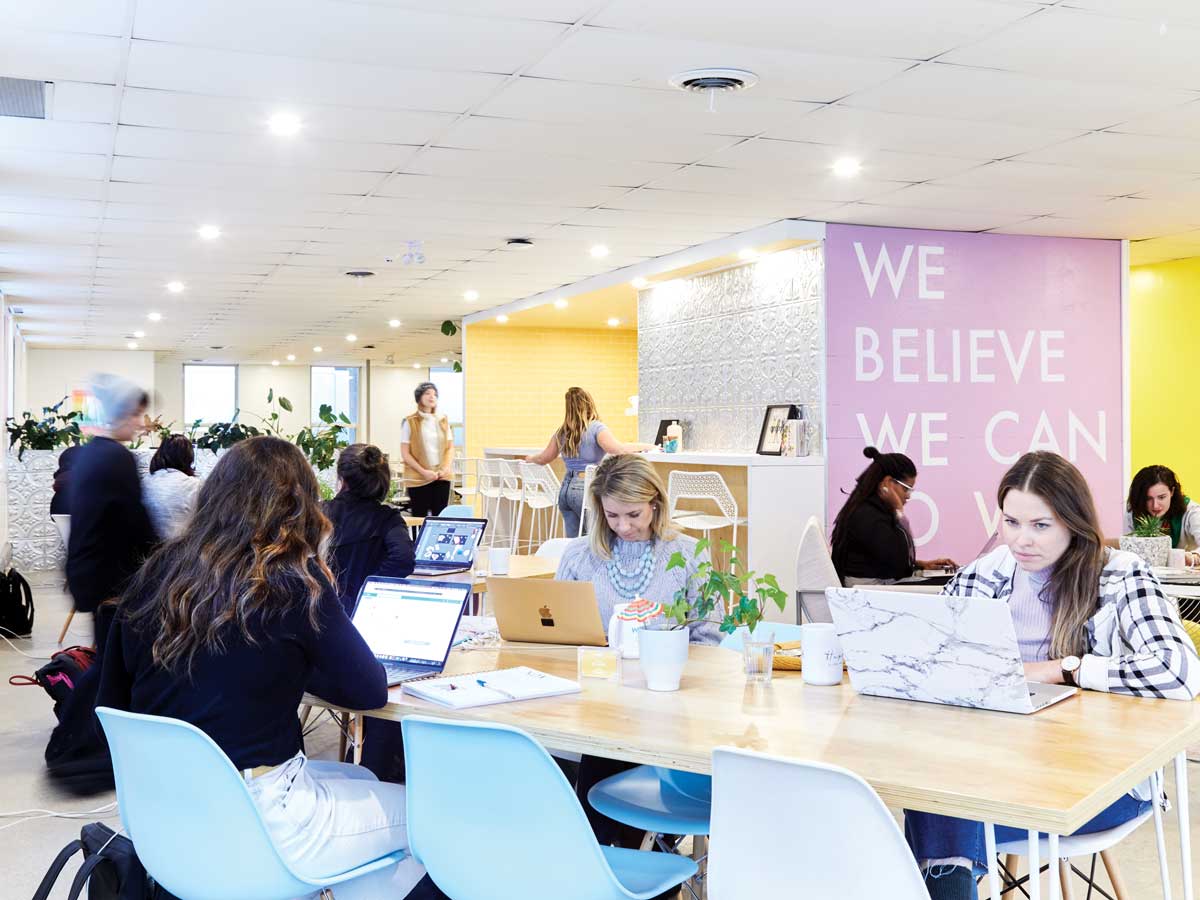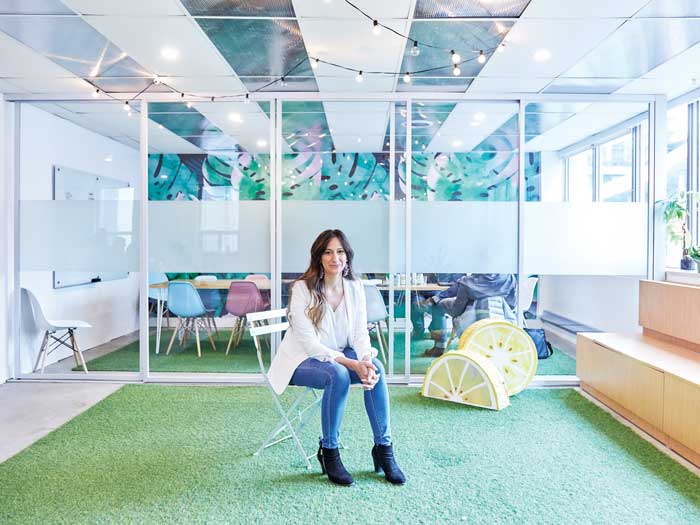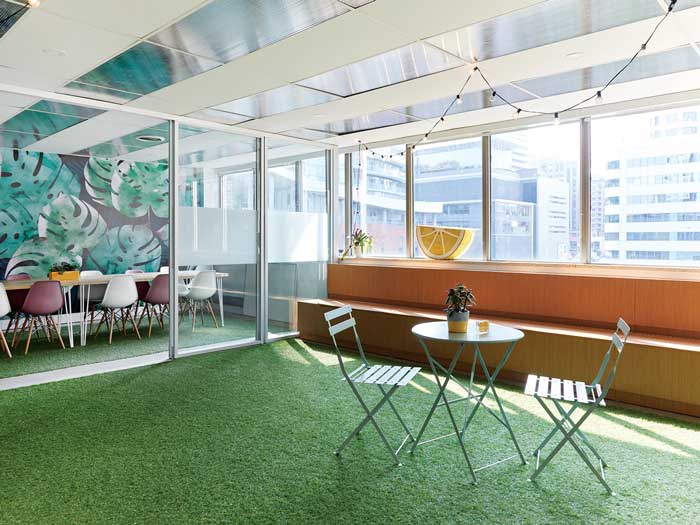
A desk of one’s own
 Make Lemonade, a co-working space in Toronto geared towards women (Photo by Derek Shapton)
Make Lemonade, a co-working space in Toronto geared towards women (Photo by Derek Shapton)
After four years at a Big Four firm and two years as a controller at a large media company, Lisa Zamparo, CPA, decided it was time for a change. She was sick of commuting into the financial district from her home in north Toronto, and she was itching to put herself in her clients’ shoes and start her own business.
In 2015, Zamparo, now 35, launched a financial planning firm aimed at helping young families. Working from home was convenient, but lonely. She had a dog, so she wasn’t the only soul in the house, but it was getting harder to wake up every morning with nothing to get dressed for and no place to go. She was also having trouble finding a space to host clients; coffee shops weren’t cutting it. “When you’re talking about taxes and a client’s finances,” she says, “you want something that’s private.” She’d tried to book conference rooms through office rental companies in the city, but they felt too corporate, too bland—all grey carpets and grey walls.
Zamparo was speaking at a startup investment event when she met Rachel Kelly. Kelly was in the midst of starting her own business, Make Lemonade, a co-working space geared to women. The two clicked, and after scrolling through Make Lemonade’s Instagram account, Zamparo decided it was exactly what she was looking for.
 Lisa Zamparo, CPA and founder of the Wellth Company (Photo by Derek Shapton)
Lisa Zamparo, CPA and founder of the Wellth Company (Photo by Derek Shapton)
“It was an interesting selling point that it was female-focused,” she says. “I hadn’t seen anything else like that. I described it as my Instagram dream come to life—it’s just so beautiful and bright and bubbly, and if I had unlimited funds to design my own home office, that’s what I’d want it to look like.” When Make Lemonade opened in the fall of 2017, Zamparo was among the first to tour the space—a bright, 3,000-square-foot office in downtown Toronto with rows of blonde-wood desks, a kitchen, three closed-door meeting rooms and a lounge space carpeted with AstroTurf, called the “patio.” Although Make Lemonade bills itself as an inclusive workplace and accepts male members, all of its roughly 200 members are women. Zamparo officially joined in December 2017. Her business, the Wellth Company, now rents four permanent desks for her and her team.
Zamparo is part of a wave of female entrepreneurs who are joining co-working spaces created foremost to serve women. As it happens, the majority of people running co-working spaces globally are also women. The co-working phenomenon is entrenched in contemporary business culture: according to Deskmag, an online publication that tracks the industry’s trends, 2.2 million people work out of 22,000 co-working spaces worldwide. Another publication, CoworkingResources, estimates there will be nearly 26,000 spaces by 2022.
2.2 million people use co-working spaces worldwide
Many of those spaces are run by WeWork, an industry giant that has opened more than 800 locations around the world since its founding in New York in 2010. But last summer, serious doubts about its leadership began to emerge: the company’s looming IPO dredged up unflattering stories about its bombastic co-founder and CEO, Adam Neumann, who was later ousted by his own board of directors. WeWork’s valuation rapidly plummeted from US$47 billion to lower than US$10 billion, and in late September, the company withdrew plans to launch an IPO.
As WeWork falters, much of the market’s recent growth comes from new, independent spaces or existing spaces diversifying their services and expanding into smaller, niche markets. Case in point: the Wing, the New York-based women’s co-working space that bills itself as “a network of work and community spaces designed with you in mind.” Founded by Lauren Kassan, 31, and Audrey Gelman, 32, the Wing has expanded to nine picture-perfect locations in the U.S. and one in London; it plans to open its first Canadian outpost in downtown Toronto this year. Since launching in New York in the fall of 2016, the Wing has raised over US$117 million; it has nearly 10,000 members and US$9.6 million in estimated annual revenue—enough to drive speculation that WeWork, which led a US$32-million Series B round in 2017, might try to acquire it.
Women-focused co-working spaces like the Wing and its competitors, which include the California-based Hera Hub and Seattle’s the Riveter, are trying to succeed in this fledgling business not by mimicking WeWork’s rapid expansion, but by doing the opposite: offering a tight-knit community with fewer locations. Gretchen Spreitzer, a professor of business administration and management at the University of Michigan’s Ross School of Business who has studied co-working, says the trend toward gender-specific spaces is a manifestation of the nascent co-working industry trying to establish a sustainable business model—and the most effective way to encourage loyalty among members is to create a community. “People might get interested in co-working because of the amenities that are offered or the professional workspace,” Spreitzer says. “But what keeps them coming back and paying that monthly fee is the feeling that they belong to the space, that there’s some kind of community. That’s especially potent for women.”
 The “patio” at Make Lemonade (Photo by Derek Shapton)
The “patio” at Make Lemonade (Photo by Derek Shapton)
Female co-working spaces are in many ways the latest iteration of the women’s club, a tradition that stretches back to the late 19th century. By 1912, one in eight women in Canada—primarily middle-class, English-speaking and white—belonged to one. They got together to study literature, art, science and philosophy. As historian Karen J. Blair points out, these clubs became incubators for the women’s rights movement. Women had no place to gather outside the home; they were denied entry to men’s clubs and were generally not welcome in the workplace. At women’s clubs, they learned to hone their public speaking skills, and organized campaigns to lobby their representatives for better school programs, public parks, drinking fountains and, of course, the right to vote. In Ontario, what began as the Toronto Women’s Literary Club eventually became the Toronto Women’s Suffrage Association, which in 1884 helped convince the University of Toronto to allow female students. “Women were empowered together,” Blair says. “They could accomplish together what they couldn’t accomplish alone.”
As women won the vote and began to enter the workforce in larger numbers, membership in women’s clubs dwindled. By the late 2000s, co-working spaces started to multiply. The movement is credited to San Francisco-based computer programmer Brad Neuberg, who opened a co-working space in 2005 citing a desire for both the freedom of the freelance life and the community and structure of office life. (Ironically, if perhaps unsurprisingly, he ended up working for Google.)
Co-working took off in the aftermath of the 2008 recession, a by-product of the gig economy. From their earliest days, co-working spaces’ workforces were dominated by women, according to Iris Kavanagh, who helped run Santa Cruz’s NextSpace, one of the first co-working spaces, from 2012 to 2014. “I was in charge of hiring and training our team, and the majority of people that were hired to work out of our spaces were female,” she says. When Deskmag began collecting data, it confirmed that her experience was typical.
1/3 of founders or owners of co-working spaces are women
In 2014, Kavanagh was fired, along with the rest of the NextSpace leadership team. “We were removed by the lead investor and chairman of the board,” she says. Three years later, she co-founded Women Who Cowork, an organization made up of 800 women who run co-working spaces around the world. The group also includes 107 co-working spaces as members, about a third of which are female-focused. But she notes that, according to Deskmag, while women represent a third of the founders or owners of all co-working spaces, they make up more than two-thirds of the people who work for them. “We see co-working as propelling women into positions of leadership within their communities,” she says. “If we can close the gender gap on funding for these women-owned spaces, we believe co-working has the opportunity to achieve gender parity.”
 The Wing’s San Francisco location (Photo courtesy of The Wing)
The Wing’s San Francisco location (Photo courtesy of The Wing)
The re-emergence of women-focused spaces is the result of both economic and social forces, including the explosion of the gig economy and the aftermath of the Me Too movement, which Blair says has shed a harsh new light on the coed workplace. Some founders of female-focused co-working spaces were motivated out of a sense of empowering their fellow women workers, and of creating an alternative to a male-dominated business culture. From 2015 to 2017, Emily Rose Antflick ran a space in Toronto called Shecosystem. She envisioned a workplace that made room for the whole self. “There’s that image of the entrepreneur who’s all hustle and doesn’t take care of themselves,” she says. “I really wanted to shift to something where self-care and wellness were a part of the workday.” Shecosystem was small—just 1,700 square feet, with about 100 members at its peak—and only opened during business hours, with no 24-7 access. It also housed a studio space, and each day began and ended with an optional “circle,” where members could gather on cushions on the floor and do breathing exercises or meditation.
When Antflick’s landlord wanted to raise the rent after her two-year lease was up, she opted to close Shecosystem. It just wasn’t making enough money. She realized that for her business model to work, she needed to rent out private offices, which felt antithetical to the spirit of her enterprise.
Still, Antflick was onto something. Many women in business are attracted to the idea of a non-traditional workplace; as Spreitzer points out, “some of the larger co-working spaces have a reputation of a ‘bro’ culture, where maybe women wouldn’t feel comfortable being there after hours.” A lot of those women also run companies that are marketed to women, which makes a good business case for joining a female-focused space—it offers the chance to network with your target demographic. Zamparo’s Wellth Company, for example, provides financial services to women who run small businesses.
2/3 of people who work for co-working spaces are women
CPA Harmik Cacace is one of 60 members at Hervana, a female-focused co-working space in Vancouver that opened in July 2018. Cacace says she finds women who own their own businesses are generally easier to talk to or approach for advice. Hervana’s founder, Meredith Garritsen, gave her the green light to host a talk about finance for the space’s members; like Zamparo, Cacace runs a financial services firm, Blue Skies Accounting, aimed at small businesses, and says she’s found new clients through other members of Hervana.
These clubs vary in pricing and membership structure, but most offer a $35-to-$50 monthly pass that gets you access to events and the use of a desk one day per month; a monthly membership where you have access to a “hot desk” for around $250 or $300; and a permanent desk for $400 to $500 a month. (At WeWork in downtown Toronto, for contrast, a hot desk goes for between $500 and $580 a month; a dedicated desk will set you back $850 a month.)
It might seem counterintuitive to pay for the privilege of working. The common critique of female co-working spaces is that they’re a kind of pink gated community—a symptom of a cultural obsession with the “girlboss,” the woman who #slaysallday at work and still manages to look fabulous out on the town at night. (One of the Wing’s selling points was that you could have a place to shower, change and do your makeup in between work and your evening plans.) These spaces market themselves as engines of female empowerment, but at these prices, they risk alienating the kind of women who might need them most. A year after the Wing opened its first location in New York, Fortune writer Polina Marinova mused, “Can you consider yourself an inclusive community when there are 8,000 women on the waitlist willing to pay thousands of dollars to join?”
For the women who join them, however, these spaces represent a shift in office culture. If this is the cost of working for yourself, in an environment where you’re surrounded by encouraging women going through similar professional challenges, maybe it’s worth it. (Plus, it’s tax deductible.) “A co-working space is more than just a place to get your work done,” Zamparo says. “For me it has become a community of business friends and clients.”
The founders of the industry envisioned the co-working office as a place where people can feel like they’re a part of something bigger than themselves. The rise of female-focused spaces is driven by a similar impulse to reimagine the working world. When Kavanagh left NextSpace in 2014, she saw it as an opportunity to do just that. “I realized that with my new ventures I was going to bring my full self as a woman rather than bend who I am for what the company needs,” she says. “That was my motivation for helping found Women Who Cowork. Women bring something unique and that’s to our advantage.”